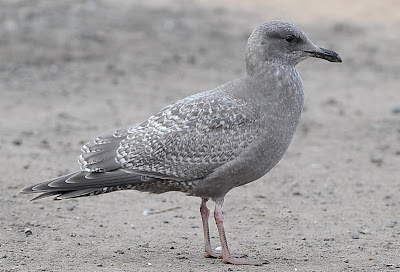Worn juvenile Glaucous Gull-Oct.9/10
The unusual part is that it appeared very worn. This is a bit odd as most of the juveniles I see especially early are crisply marked. I thought this was likely at least a week or two before my early date but on checking I had a juvenile last year on Oct.10th.
Worn juvenile Glaucous Gull-Oct.9/10
Separating first from second year Glaucous Gulls in fresh plumage is not difficult but it can be more challenging when they are worn or in more southern areas and later in the season sun bleached. A simple way to separate them without having to look at the plumage is by their bill. Juvenile birds have a bicolour bill -pink with a black tip. Second winter birds have a similar bicolour bill but it has a little pink tip beyond the black.
Juvenile Glaucous Gull
This is quite typical of the juvenile plumage we see in the late fall -early winter. Note the black tip to the bill.
Second winter Glaucous Gull
Second winter Glaucous Gull
Although the pink bill tip on second year birds is a bit subtle it is relatively easily seen. Clearly in the fall the vermiculated beige look of the juveniles is easily distinguished from the white blotchy look of the second year birds.
I took several pictures of what at the time I pegged as an odd juvenile Herring Gull. Its plumage was so immaculate it acutely glistened in the sun. It was a very uniform milk chocolate brown. I had a Herring Gull like this a few years ago so I jumped to the conclusion it was of the same ilk. After examining the pictures I quickly came to the conclusion it was a juvenile Thayer's Gull. I have never seen a Thayer's previously with this warm chocolate brown colour with no contrasting colours on the mantle,coverts or tertials. Maybe with a little wear it will appear a bit more contrasting.
Juvenile Thayer's Gull
Juvenile Thayer's Gull
The structure of this bird is very much in keeping with Thayer's Gull especially the rather modest bill.
The primaries are a dark brownish with thin white chevrons and on the open wing shot the pigment is mostly restricted to the outer webs. The inner primaries have very little pigment with just a tinge of brown at the tips. Howell and Dunn have a nice picture comparing first cycle Thayer's and Herring wings on page 27 of Gulls of the Americas.
Juvenile Thayer's Gull
Juvenile Thayer's Gull
Juvenile Thayer's Gull
Juvenile Thayer's Gull
Juvenile Thayer's Gulls can be quite varied but are usually much more contrasting on the topside with a lot of white edging to the scapulars and coverts and a lot of marbling of the tertials. Many Thayer's Gulls will be as dark as this bird but most will be lighter.
Dark juvenile Thayer's Gull
Dark juvenile Thayer's Gull
Dark juvenile Thayer's Gull
A bunch of lighter specimens follow.
Lighter juvenile Thayer's Gull
Lighter juvenile Thayer's Gull
Lighter juvenile Thayer's Gull
(maybe a bit of kumlieni in this one)
As I mentioned earlier I did have a Herring Gull a few years ago that was a uniform chocolate brown like this bird. Note the similarities and differences below.
Juvenile Thayer's Gull

Juvenile Herring Gull
Note the differences in structure especially the bill. In the Herring Gull note the base of the bill is turning pink something that would be extremely unusual for a Thayer's at this time of year. Both of these birds are in immaculate plumage. Note the Thayer's has broadly rounded primaries and the Herring has sharply pointed primaries. I have noted this difference on many occasions and on checking a bunch of reference pictures I did come across a strong trend towards confirming this as a differentiating feature.
Kirk Zufelt


















No comments:
Post a Comment